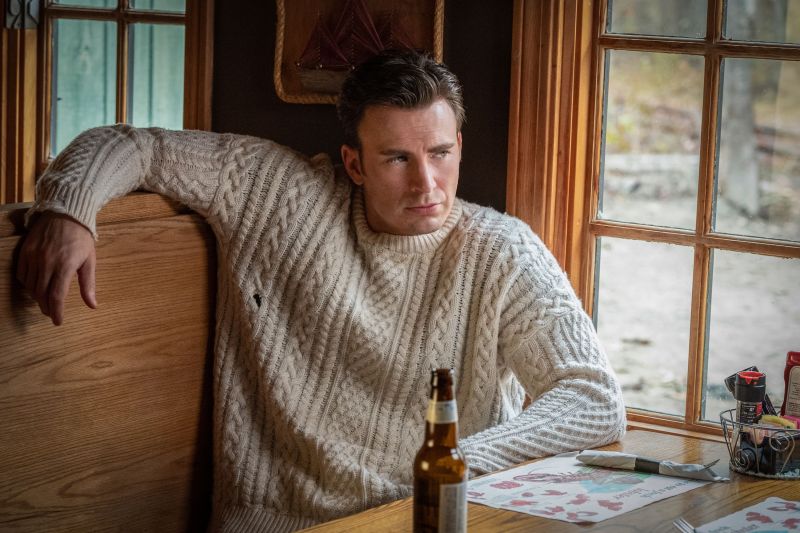
By all accounts, the 2019 film Knives Out was a success. The star-studded “Who done it?” netted eight times its budget at the box office and became a viral hit when it reached streaming platforms. The script even garnered an Academy Award nomination for Best Writing. Yet all this success was overshadowed by a chunky old sweater worn by Chris Evans in two scenes. The off-white, vintage-looking cable knit sweater stole the show, first on social media and then throughout fashion and lifestyle editorials. At some points, Evans’ chunky sweater collected far more attention than the film itself.
The classic Anglo-Irish fisherman’s sweater featured vertical rows of various Celtic knots with ribbed cuffs, collar, and waist. The sweater has a few holes and a tear in the collar. but they only serve to enhance the coziness — appearing worn in, not worn out. It resonated so profoundly with audiences because it looks so unbelievably comfortable and stylish at the same time. The loose-knit ribbing gives a loose, stretchy appearance without looking baggy. The sleeves drape just over the shoulders and fall below the wrists, providing an enveloping sensation. The off-white color and classic knit pattern are so entrenched in American-style heritage that the sweater will match practically anything you wear with it. In short, it is a perfect chunky sweater.
Chunky sweaters are as much a staple of winter menswear as flannel and corduroy. The styles we wear today — like fisherman’s cable knits, shawl cardigans, and ragg wool crew necks — have been around since the early 1800s. Fabrics and production methods have changed greatly, but the men’s sweater styles have remained the same. That kind of longevity in fashion speaks to the exceptional performance and appealing aesthetic of these classic designs. So let’s dive into what has made these chunky sweaters so successful and why they’re a must-have for every man’s fall and winter wardrobe to this day.

Chunky sweaters are functional
Most chunky sweater designs were inherited by Americans from our European ancestors. The sweater designs we have today were developed in the early 1800s in the U.K. and Ireland. These countries had an abundance of sheep’s wool, so it was cheap to use for knitted garments. The crew neck sweater and cardigan became warm and durable garments for the poor and working classes who couldn’t afford tailored clothing. Many of them were produced at home using methods that had been passed down for generations.
Sailors and fishermen along the northern coast of America first adopted these chunky sweater designs from their brethren on the other side of the Atlantic. That is why heavy wool sweaters, especially cable knit designs, are synonymous with New England. Wool is very effective at insulating heat and repelling water, which proved effective for more than just seafaring. By the late 1800s, everyone from farmers and lumberjacks to factory workers and firefighters were wearing chunky wool sweaters.
Cable knit and large rib knits aren’t just decorative; they create a sweater with a lot of give for comfort and mobility. The larger gaps on the knit also allow breathability because layering that much wool on top of your body can cause your body to overheat even in cold environments. The shawl neck replaced a jacket collar and provided the functionality to flip up in adverse weather conditions. The roll neck became popular in the late 1800s as a functional feature that can roll up or down depending on the weather. This was a more adaptable alternative to a standard turtleneck. Cardigans began to feature zippers in the early 1900s and became an outerwear option.

Sweater fabrics have evolved
All chunky sweater designs were made out of wool a century ago. Sheep’s wool is a wonder of nature because of how well it insulates heat, defends against wind and water, and even protects against microbes and bacteria. Even the most advanced artificial fabrics that humans have created cannot replicate all the properties that wool possesses. You can wear a wool sweater a dozen times without washing it, as long as you don’t spill anything on it, and it will remain cleaner than a cotton shirt worn once.
A variety of natural and artificial fabrics have been introduced to the commercial sweater market over the past few decades. Cashmere and alpaca are more luxurious options because they’re softer, but they sacrifice durability. Alpaca has grown in popularity over recent years but has not yet become a commercially available textile. When you’re looking for an all-natural chunky sweater, the best option is a blend. Something that is at least 75% wool with a mix of cashmere, alpaca, or both will provide sufficient durability while offering a softer feel. The only issue is that, while still cheaper than full cashmere, blends are more expensive than full wool and much less common.
Artificial fabrics have created a whole new “performance” category in the sweater market. These fabrics can be divided into two categories: poly and stretch. All fabrics that begin with names that begin with poly are carbon-based textiles derived from crude oil. They are essentially just a cheaper alternative to natural fabrics and allow brands to cut prices. Stretch fabrics are elastic-based and are used to provide an easier range of motion in garments traditionally made from natural fabrics. The explosion in stretch fabrics, usually featuring between 2% and 10% elastic, is a byproduct of the athleisure movement.
A chunky sweater that features a natural and artificial blend allows a brand to provide the best of both worlds. Wool or cashmere provides durability, protection, and insulation, while artificial fabrics provide mobility and cut the cost of the garment for everyone involved. The choice between artificial and natural fabrics comes down to what you’re looking for in your chunky sweater. If you want longevity, durability, warmth, and protection from the elements, then stick to 100% natural fabrics. If you want something lighter weight, more breathable, easily machine washable, and flexible, then go with an artificial blend.

How a chunky sweater should be styled
Chunky sweaters were born out of functionality, but they have become classic because they are stylish. Thick, oversized sweaters that overtake the wearer exude nonchalance, taste, and sophistication. They carry an air of academia and old-money leisure. Wearing one expresses an elevated comfort level to the world as much as it does to the wearer. Sweaters that started out as working-class apparel became leisure wear for the money class in the early 1900s. The roll necks, cable knits, shawls, and cardigans worn by young men at Ivy League schools after WWI became foundational elements of preppy style. Brands like Ralph Lauren, L.L. Bean, and Brooks Brothers plucked those sweaters from campuses and parlor rooms and then distributed them to the masses.
Now chunky sweaters belong to everyone, and they look good on everyone. If you’re looking for your first one, then a cable crew neck like the one from Knives Out is a great place to start. An intricately detailed Celtic knot pattern in 100% wool is what to look for. They look perfect with jeans or cords. You can wear them with a pair of slacks and dress shoes for a more elevated look. Adding a scarf really completes the cozy New England look.
It is never a bad idea to channel The Dude with an oversized cardigan. His was a full zip, but a button-down type is more versatile. You can go with a solid color for more styling versatility, but an original pattern is much more fun. They often come in patterns derived from Native American blanket weaving. This tradition comes from the American Southwest, where cowboys and ranchers adopted Native motifs. When styling these, you should think of them as a replacement for a blazer or light jacket. The best part about wearing a cardigan is that they are essentially cropped robes that are acceptable to wear in public — that’s how comfortable they are.
A deeper-cut option is a big beefy roll-neck sweater. J.Crew made the most iconic roll-neck sweater with a matching roll sleeve and torso from the 1980s through the early 2000s. The company brought it back a few years ago with a ribbed cuff. Roll necks look best in solid colors or in a rugby stripe pattern. They go well with chinos or jeans paired with loafers, boots, or moccasins. A boiled wool roll neck will be the warmest sweater you own and keep you cozy through the depths of winter.

Won’t you wear my sweater?
With apologies to Chris Evans, the above picture shows what could be one of the most famous chunky sweaters ever to be knit.
Do you recognize it? Sure you do.
It’s one of the zip-up cardigans made famous by the legendary Fred Rogers on Mister Rogers Neighborhood. Now you may be wondering why we are talking about a sweater that is now a museum piece instead of a wardrobe piece. That’s because now you can wear the zipped cardigans made famous by Mister Rogers thanks to the Sun Valley .
Sun Valley Alpaca Company has introduced its “Mister Rogers Sweater Collection,” with six styles of zippered cardigans that Rogers made famous during his show (and yes, the one pictured above is included in the line) made from 100% alpaca wool to keep you warm and stylish. So whether you’re out for a beautiful day in the neighborhood or a stylish night on the town, this sweater is a perfect fit.

A wardrobe essential
Simply put, chunky sweaters are an essential for any man’s wardrobe. They’re the coziest way to look stylish during the cold weather months. Almost every menswear brand makes at least a couple of options, and they’re available in everyone’s price range, no matter what budget you’re working with. A go-to chunky sweater is a great fallback outfit because you can simply wear it with a pair of jeans and any shoes and you’re good to go. Top it off with a scarf and topcoat and you’ve got a perfect fall or winter outfit. An abundance of versatility, functionality, and timeless style will make you and your chunky sweater steal every scene you walk into.



